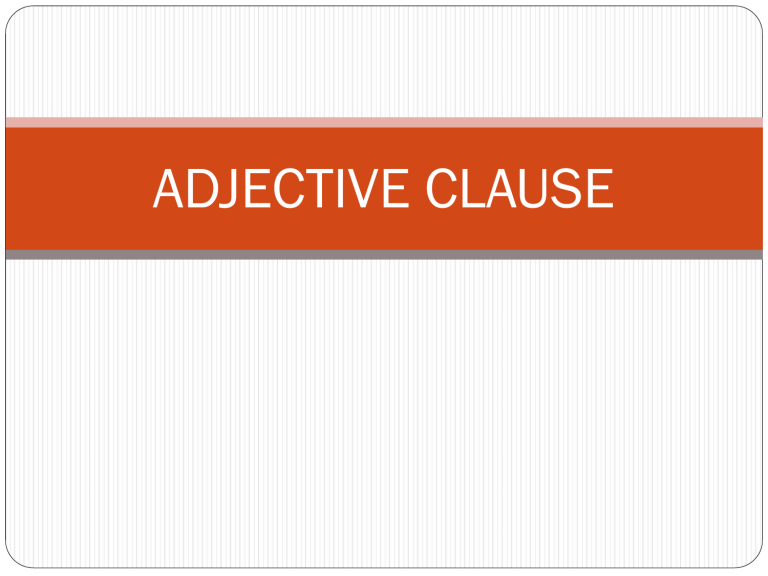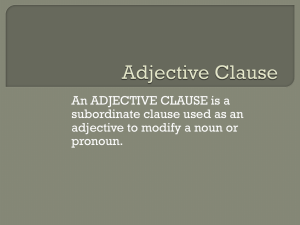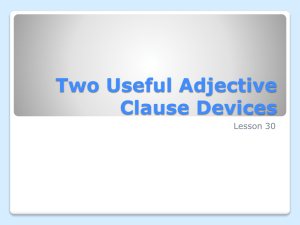ADJECTIVE CLAUSE
advertisement

ADJECTIVE CLAUSE ADJECTIVE CLAUSES: INTRODUCTION ADJECTIVES An adjectives modifies a noun. “Modify” means to change a little. An adjective describes or gives information about the noun. Adjective usually comes in front of a noun. (a) I met a kind man adjective +noun (b) I met a famous man ADJECTIVE CLAUSES An adjective clause* modifies a noun. It describes or gives information about a noun. An adjective clause follow a noun © I met a man who is kind to everybody. (d) I met a man who is a famous poet. (e) I met a man who lives in Chicago. noun + adjective clause *grammar terminology A clause is a structure that has a subject and a verb. There is two kinds of clauses: independent and dependent. - An independent clause is a main clause and can stand alone as a sentence. - A dependent clause cannot stand alone as a sentences; it must be connected to an independent clause. (1) I met a man = an independent clause; it is a complete sentence. (2) He lives in Chicago = a dependent clause; it is NOT a complete sentence. (3) who lives in Chicago = a dependent clause; it is NOT a complete sentence. (4) I met a man who lives in Chicago = an independent clause + a dependent clause; a complete sentence. USING WHO AND WHOM IN ADJECTIVE CLAUSES S V (a) The man is friendly. He lives next to me. ↓ who who lives next to me. (b) The man who lives next to me is friendly. In (a): He is a subject pronoun. He refers to “the man.” To make an adjective clause, change he to who. Who is a subject pronoun. Who refers to “the man.” In (b): An adjective clause immediately follow the noun it modifies. Incorrect:The man is friendly who lives next to me. s v o © The man was friendly. I met him. ↓ whom o s v whom I met. (d) The man whom I met was friendly. In ©: him is an object pronoun. Him refers to “the man”. To make an adjective clause, change him to whom. Whom is an object pronoun. Whom refers to “the man.” Whom comes at the beginning of an adjective clause. In (d): An adjective clause immediately follow the noun it modifies. Incorrect:The man was friendly whom I met. USING WHO, WHO(M), AND THAT IN ADJECTIVE CLAUSES s v (a) The man is friendly. He lives next to me. | s v who/that (b) The man who lives next to me is friendly. © The man that lives next to me is friendly. In addition to who, that can be used as the subject of an adjective clause. (b) and © have the same meaning. A subject pronoun cannot be omitted. Incorrect:The man lives next to me is friendly. Correct:The man who/that lives next to me is friendly. s v o (d) The man was friendly. I me him. ↓ o s v whom/that (e) The man who(m) I met was friendly. (f) The man that I met was friendly. (g) The man Ѳ I met was friendly. In addition to whom(m), *that clause can be used as the object is an adjective clause. (e) and (f) have the same meaning. An object pronoun can be omitted from an adjective clause. (e), (f) and (g) have the same meaning. In (g): The symbol “Ѳ” means “nothing goes here.” USING WHICH AND THAT IN ADJECTIVE CLAUSES s v (a) The river is polluted. It flows through the town. ↓ which/that s v (b) The river which flows through the town is polluted. © The river that flows through the town is polluted. Who and whom refer to people. Which refers to things. That refers to either people or things. In (a): To make an adjective clause, change it to which or that. It, which, and that all refer to a thing (the river). (b) and © have the same meaning. When which and that are used as the subject of an adjective clause, they CANNOT be omitted. Incorrect:The river flows through town is polluted. s v o (d) The books were expensive. I bought them. ↓ o s v which/that (e) The books which I bought were expensive. (f) The book s that I bought were expensive. (g) The books Ѳ I bought were expensive. Which or that can be used as an object in adjective clause, as in (e) and (f). An object pronoun can be omitted from an adjective clause, an in (g). (e), (f) and (g) have the same meaning. SINGULAR AND PLURAL VERBS IN ADJECTIVE CLAUSES (a) I know the man who is sitting over there. In (a): The verb in the adjective clause (is) is singular because who refers to a singular noun. (b) I know the people who are sitting over there. In (b): The verb in the adjective clause (are) is plural because who refers to plural noun, people. USING PREPOSITIONS IN ADJECTIVE CLAUSES The man was helpful. obj. (b) The man whom © The man that (a) prep obj. to him. I talked prep I talked to was helpful. I talked to was helpful. Ѳ I talked to was helpful. prep obj. (e) The man to whom I talked was helpful. Whom , which, and that can be used as the object of a preposition in an adjective clause. Reminder: An object pronoun can be omitted from an adjective clause, as in (d) and (i). In very formal English, a preposition comes at the beginning of an adjective clause, as in (e) and (j). The preposition is followed by either whom or which (not that or who), and the pronoun CANNOT be omitted. (b), ©, (d), and (e) have the same meaning. (d) The man (f) The chair is hard. I am sitting obj. prep (g) The chair which I am sitting in (h) The chair that I am sitting in prep in is hard. is hard. Ѳ I am sitting in is hard. prep obj. (j) The chair in which I am sitting is hard. (g), (h), (i), and (j) have the same meaning. (i) The chair obj. it. USING WHOSE IN ADJECTIVE CLAUSES (a) The man called the police. His carwas stolen. ↓ whose car (b) The man whose car was stolen called the police. Whose* shows possession. In (a): His car can be changed to whose car to make an adjective clause. In (b): whose car was stolen = an adjective clause. © I know a girl. Her brother is a movie star. ↓ whose brother (d) I know a girl whose brother is a movie star. In ©: Her brother can be changed to whose brother to make an adjective clause. *Whose and who’s have the same pronunciation but NOT the same meaning. Who’s = who is. Who’s (who is) your teacher? (e) The people were friendly. We bought their house. ↓ whose house. (f) The people whose house we bought were friendly. In (e): Their house can be changed to whose house to make an adjective clause.








